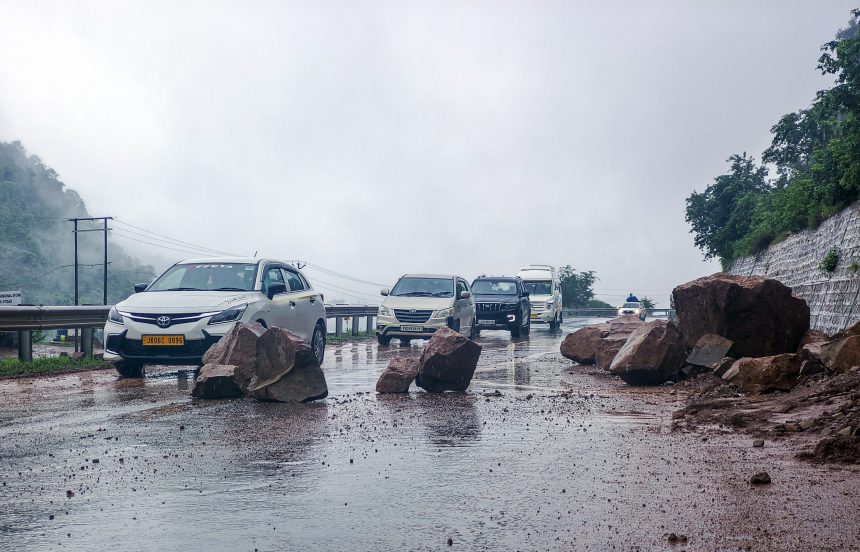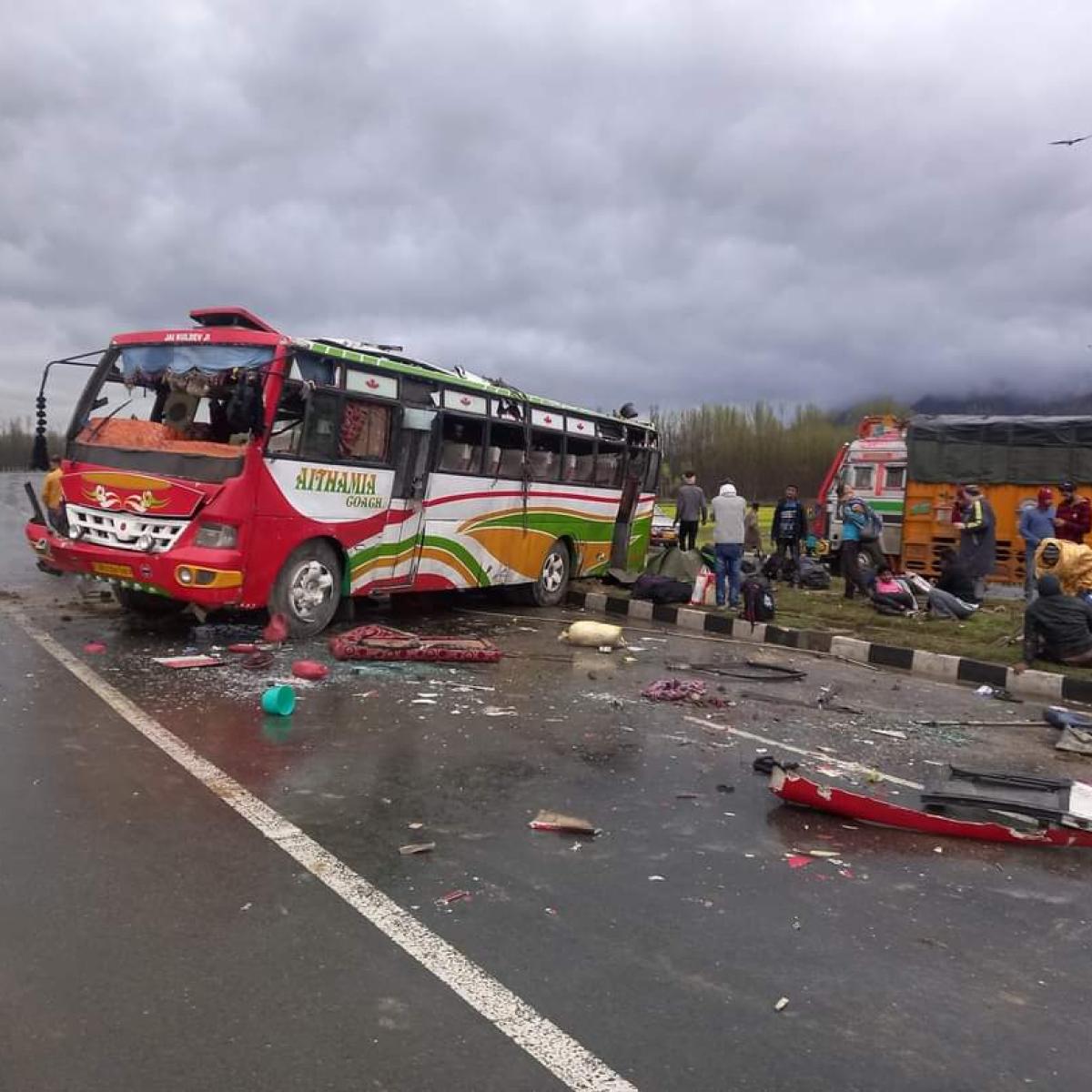Nature’s Wrath Unleashed: Landslides, Flash Floods Cripple Jammu–Srinagar National Highway
By: Javid Amin | Srinagar | 28 July 2025
Jammu–Srinagar Highway Paralyzed by Monsoon Havoc
The Jammu–Srinagar National Highway (NH-44)—a critical artery linking Kashmir with the rest of India—has once again fallen victim to relentless monsoon rains, triggering landslides, flash floods, and falling boulders, leaving thousands of civilians, tourists, and Amarnath Yatra pilgrims stranded.
Reasi Tragedy: Two Workers Killed in Landslide
In one of the most heart-wrenching incidents, two laborers were buried alive in the Reasi district while preparing a pilgrimage track for the Machail Mata Yatra. Their bodies were recovered after hours of difficult rescue operations, highlighting the grave risks faced by workers in high-altitude construction zones during the monsoon.
Ground Zero: Areas Worst Hit by Weather Mayhem
Multiple stretches along the treacherous NH-44, especially between Ramban and Banihal, have become virtually impassable due to:
-
Massive landslides at Magarkote, Seri, and Mehar
-
Falling rocks and shooting stones near Panthyal and Nachlana
-
Flooded roadways and collapsed culverts in Udhampur, Rajouri, and Ramban
Thousands of commuters, including Amarnath Yatra pilgrims, have been forced to seek shelter in temporary roadside facilities or return to base camps.
“The highway is blocked at multiple locations. Restoration work is hampered due to continuous rainfall and fresh slides,” said a senior Border Roads Organization (BRO) official.
RED ALERT: IMD Issues Extreme Weather Warning
The India Meteorological Department (IMD) has issued a Red Alert across several districts in Jammu and Kashmir, including:
-
Ramban
-
Kathua
-
Udhampur
-
Reasi
-
Poonch
Key alerts include:
-
Very heavy rainfall
-
Potential flash floods
-
Rising river levels, particularly in Chenab and Tawi basins
Citizens have been advised to stay indoors, avoid travel through landslide-prone areas, and remain alert to emergency advisories.
Strategic Implications: More Than Just a Road
The NH-44 is far more than a transportation corridor. It serves as a **lifeline for:
-
Local civilians and daily commuters
-
Essential goods and fuel supply chains
-
Emergency medical transport
-
Tourists and yatris
-
Strategic military logistics
Repeated breakdowns of this highway underscore deep-rooted infrastructure fragility in J&K, where weather-driven disasters paralyze life and logistics in a matter of hours.
“This is a serious issue of national connectivity and disaster preparedness. NH-44 needs a permanent overhaul, not patchwork repairs,” noted a transportation expert from the National Institute of Disaster Management.
Why NH-44 Is Prone to Collapsing Each Monsoon
Geological Instability
The highway cuts through steep sedimentary mountains, rich in shale and sandstone—rocks that disintegrate quickly under rainfall. Areas like Panthyal, Mehar, Nachlana, and Kishtwari Pathar are notorious landslide zones, collapsing under minimal water load.
Unplanned Development
Massive road widening projects, tunnel drilling, and embankment work have disturbed the natural drainage systems. Improper water channeling leads to:
-
Undermined slopes
-
Soil saturation
-
Blocked culverts and gorges
Climate Change Amplification
This year’s monsoon is part of a broader pattern of erratic and extreme weather:
-
Shorter but more intense rain bursts
-
Glacial melt and saturated groundwater tables
-
Increased frequency of flash floods and slope failures
“This is not just climate change. It’s climate emergency. Our infrastructure is not adapting fast enough,” warned an IIT Roorkee climate scientist.
Amarnath Yatra in Jeopardy Again?
The ongoing Amarnath Yatra, a massive annual pilgrimage involving lakhs of devotees, is once again facing serious disruption. With NH-44 blocked, transportation of pilgrims, rations, and medical supplies has slowed down.
Authorities are considering:
-
Temporary suspension of Yatra convoys
-
Re-routing plans via alternate roads (Mughal Road, if weather permits)
-
Airlifting essentials to key base camps
“Our priority is pilgrim safety. We are constantly monitoring the highway and weather patterns,” said a J&K Disaster Management spokesperson.
Connecting the Dots: The Climate Crisis Comes Home
What’s happening on NH-44 is not just bad weather—it’s climate disruption in real-time.
Experts have long warned that Jammu & Kashmir’s fragile ecosystems are being pushed to the brink by:
-
Aggressive infrastructure expansion
-
Blocked or diverted watercourses
-
Glacial retreat and soil erosion
-
Absence of slope stabilization and early-warning systems
Every year, the monsoon becomes more unpredictable, and every year, NH-44 reminds us how unprepared we are.
The Road Ahead: What Needs to Be Done
To mitigate such disasters in the future, experts and civil society demand:
-
Permanent slope stabilization projects
-
Tunneling bypasses through vulnerable zones
-
Geotechnical risk mapping before new projects
-
Advanced landslide early warning systems
-
Climate-resilient construction codes
Final Word
The Jammu–Srinagar Highway is more than a road—it is the region’s economic artery, security lifeline, and social connector. As landslides, flash floods, and weather emergencies become the new normal, the repeated paralysis of NH-44 sends a clear message: Our infrastructure must evolve—or collapse will be inevitable.



